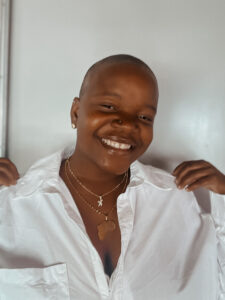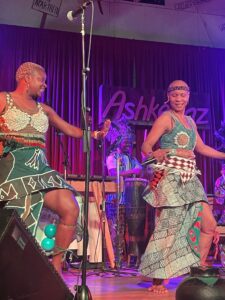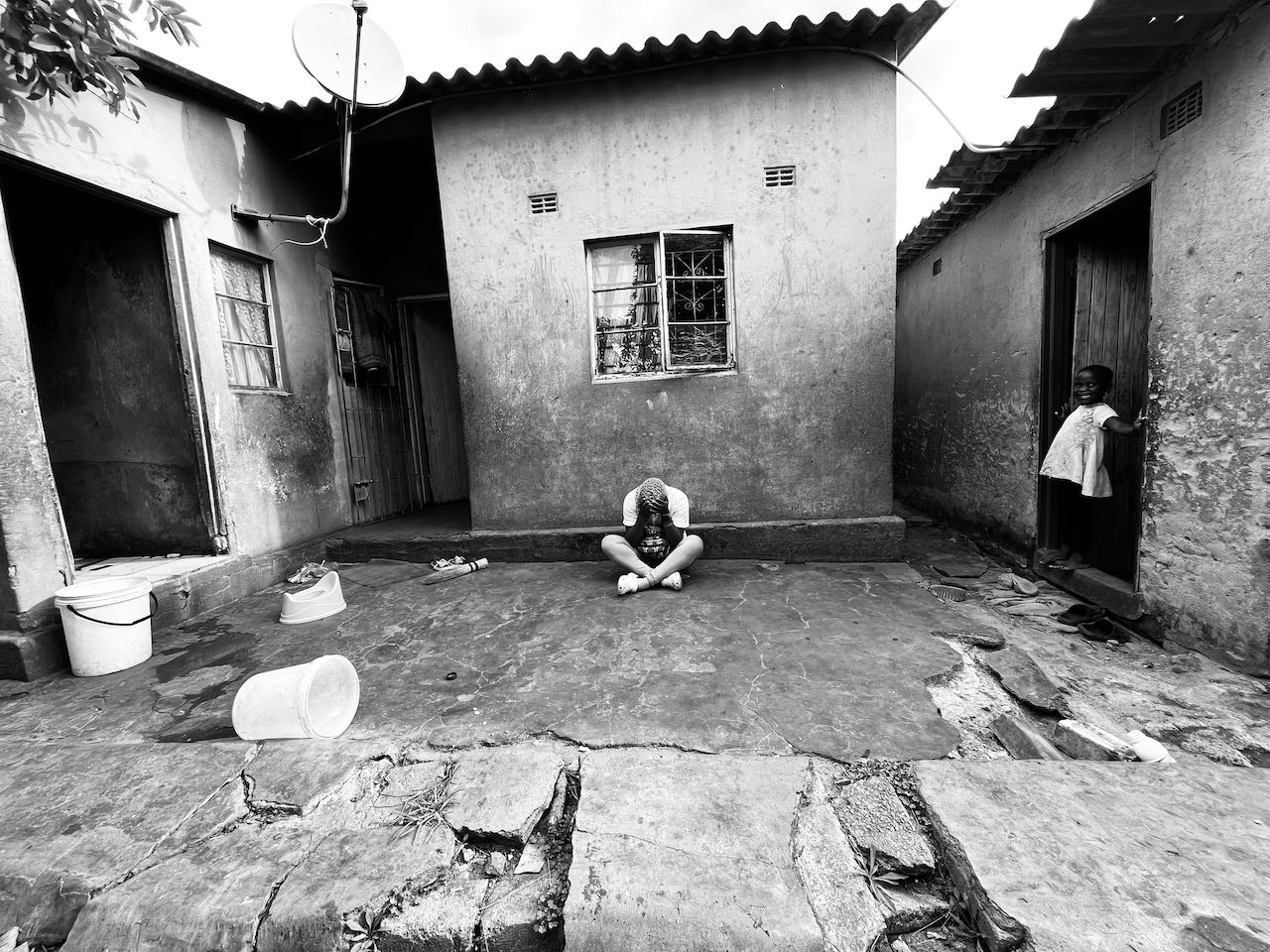Photo by Isabel Chigamba
[ID: Kanukai Sitting in the middle of the verandah at the first Chigamba family home in Zororo, Highfields. There are a couple of white buckets to her left side and a kid on her far right side. Kanukai’s head is tilted down while her hands are on her head.]

[ID: Kanukai Chigamba dressed in a white long-sleeve shirt in front of a white background wall. Wearing two necklaces of a map of Africa and the letter K. She has a gold nose ring. She is smiling while her hands are on her shoulders.]
“Madhuweeeee, nyatso kuchema kunge wafirwa. I need to hear the sadness of the little girl you are singing about in your voice.” Mhamha Henry would shout during Mhande rehearsals where I had to lead the song Mudzimu Wangu. I would play around with high and low cries while singing it until she said “yeaaaahhh, that’s it, we are almost there.” The memory of how I learned this song has stuck with me until today. It is one of my favorite songs to sing and dance to. Everytime people hear me sing this song, they are moved which always takes me back to when I learned it.
Mhamha Henry, my aunt, the oldest child in my mother’s family. One of the greatest mbira players and dancers in Zimbabwe. Mhamha Henry always had a way of getting you to reach a part of yourself, you did not know you had, until she shook you a couple of times. Some days, she would show you a dance move or song once, and you better make sure you do something as close to that, if not better, when it’s your turn. For the most part, this has been how I learned music and dance. In my family, we learned our traditional dances by watching older family members during Bira ceremonies or while hanging out at home.
“Zvinhu zvese zvatiinazvo…zvinoda kupembererwa baba…”, different high and low pitches of people who were singing and celebrating in one of the new thatched houses at our family home in Hatfield would wake the dead. Whether it was the sharp down and the heart of the beat, hosho being played or maoko arikuomberwa, or the drum or a long line of mbira players running their fingers on that instrument like it doesn’t hold about 28 keys on it, every intricate sound made in that room created one beautiful mbira song that highlighted how people felt in that moment.

[ID: Laiza Muchenje-Chigamba (Ambuya) sitting in front of the Chigamba family main house with her son, Henry Chigamba and 13 of her grandchildren who are eating corn porridge. Ambuya is wearing a blue robe and green head scarf, while the grandchildren are wearing different colors that range from blue, white, pink and so forth.]
Around 2002-3, Asekuru Chigamba and Gogo Achihoro, my maternal grandparents, hosted an all night Bira ceremony to bless our new home in Hatfield. Think of a house warming party, but instead of people bringing gifts such as plants or wall art, people brought all-night prayers and a search for guidance and protection of the new home from the ancestors through music and dance. Family and friends from afar danced, sang, ate, and drank hwahwa, masese eseven days. At eight years old, I struggled to stay awake. Yet, in the early hours of the morning, my uncle, Sekuru Joe, decided it was the best moment to have my cousins and I sit in front of him to sing the Zimbabwe national anthem and create choreography to it. Thanks to Solomon Mutswairo & Fred Changundega, who composed a song with very similar sections, so we mixed up the lyrics and struggled through the whole session.
“Okay, iwewe Wadza, imba tione, since you want to act like you already have it all set.” Sekuru Joe gave Wadza, a tyrannical look as he put her on the spot to sing. As we fought yawns, and the shutting of our eyelids, Wadza, my older cousin sister, got up, fixed her skirt and stood in front of us giggling like a baby hyena. Buju, my older cousin brother, and childhood partner in crime, who sat next to me, bumped my shoulder to draw my attention to Wadzas nervousness. Of course, this made us all laugh like water faucets that couldn’t shut. Through our shenanigans, with her chest up and head help up high, Wadza sang the “Kubvira, kubva Zambezi kusvika Limpopo…” part first, instead of the “Neropa, neropa zhinji ramagamba…” Before we could utter ours, Wadza led the choir by laughing like a lost wild goat.
Sekuru Joe’s chronicles of teaching us dance were always comedic. One day, while practicing Dinhe, my cousin, Moses/Mhozi, struggled to coordinate his arms and legs. After he’d had enough, Sekuru Joe’s tall frame rose up from his chair asking us if we do not know how to walk normal. “When you walk normal, your arms and legs naturally go opposite. I have never seen a person that steps with their right leg and their right hand follows.” Again, uncontrollable laughter ensued. We had created complexity from a part of our everyday life activities.
“Ndave kuenda ini…” Ambuya would calmly sing and pause from her favorite sofa in the living room, the one with the best view of the TV. Once we heard her sing this line, we knew we were in for a long night. Ambuya Chihoro was our matriarch, and whenever she had us dance and sing one of her favorite songs ‘Ndave Kuenda (I am leaving)’, she took her time. How dare you start clapping before we arrive at the right groove for the call and response? Ambuya would silently give us another chance to get the song right. She would give us the lead line again, just a little louder than the last time.

[ID: Kanukai & Julia Chigamba performing at Dance and Music Community Center in February of 2023. They are both wearing skirts made of different Zimbabwean batik fabric styles in shades of blue. They are also wearing blue and brown tops with beads and cowry shells. They are wearing magavhu (leg rattles).]
Singing this song now, hits differently. Chinyakare Ensemble, our family performance group in Oakland, founded by my mother, Julia Chigamba recently performed at Ashkenaz Music and Dance Community Center. I am convinced that our family has a deep connection to Dinhe rhythm. During our soundcheck, Ndave Kuenda was the song that came out of me unknowingly when I was asked to check the mic. I respected Ambuya wanting to be in the space and went with the flow, but I could not finish as tears flooded my eyes and cheeks. My grandmother died in 2005, and her passing left a huge hole in my family. She was the keystone to the family. Everyone knew you could always come and dance kumba kwaAchihoro. Growing up, our time was filled with each other. When there was no electricity we would sit around the fire with Ambuya and other adults. We would sing, play games and dance until people started retiring to their bedrooms one by one. Our personal lives were not separate from our artistry, it was all blended in one like a hot pot of gango.
“Nyarara mwana, Nyarara mwana…” I started slowly pronouncing the high and low parts to Mudzimu Wangu’s response at Dance Mission Theater during a closing circle after the viewing of the Mixtape of the Dead & Gone #1 performance I was a part of in 2022. It was a room filled with people who had just experienced death at a very intimate level through Nkeiruka’s work. A smile of “yes, that’s it, we are almost there” feeling escaped my mouth the moment I felt people had reached a good place of pronouncing and singing these Shona lyrics beautifully. I reached for the girl Mhamha Henry once helped me search for within me, and we sang until everyone was sounding like one voice.
My grandmother had a way of expressing love through dance and music. Even if you did not know the song she was sharing with you, you could feel the warmth of her heart through her voice. Since moving to the Bay Area in 2010, I have felt a similar feeling from my mother. Whether we are singing “Kura Uone” for the 100th time at home or at performances, or as she decorates our house like a museum with endless Zimbabwean and African artifacts, my mother has found a way to keep my siblings and I connected to our roots. She has built a home away from home. This has also given us a way to communicate and learn in ways that I did not know would help me stay grounded in my own journey as an artist.
This article appeared in the Spring 2023 issue of In Dance.


